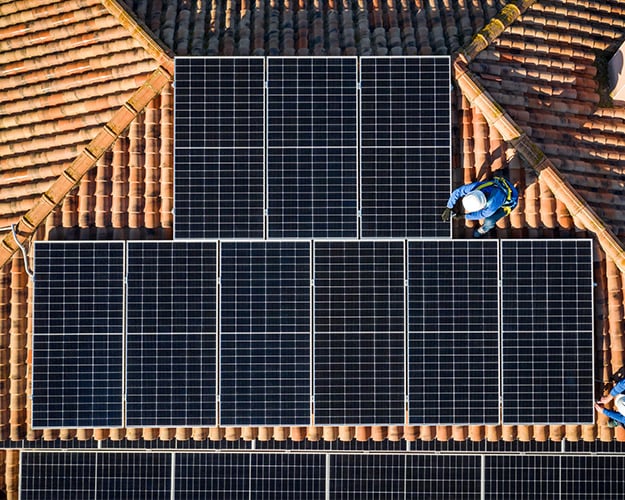Key Takeaways
- The Inflation Reduction Act (IRA) has expanded energy incentives, including Section 48, to encourage organizations to invest in qualified clean energy and energy-efficient property.
- Section 48 is a credit for qualifying energy property, including solar, geothermal, microgrid, energy storage, and other clean energy technologies.
- To maximize the benefit of Section 48, organizations need to meet specific qualifications, be aware of effective dates, and consider working with firms experienced with clean energy investments.
Several new and expanded forms of clean energy incentives are available for taxable and tax-exempt organizations as part of the Inflation Reduction Act (IRA).
Section 48, a tax credit supporting investments in qualified clean energy and energy-efficient property, is among these clean energy incentives.
What is the Section 48 Credit?
Section 48 is an Investment Tax Credit (ITC) for clean energy and energy-efficient properties, including solar, geothermal, microgrid, energy storage, and other clean energy technologies.
To calculate the credit, Section 48 provides a base credit of 6% or, if the increased credit amount requirements are met, the credit percentage increases to 30%. Additionally, there are bonuses for using domestic content and being located in an energy community. These bonuses are an additional 10% each if the prevailing wage and apprenticeship requirements are satisfied, or if one of the exceptions are met. Otherwise, these bonuses are an additional 2% each. Once the percentage is determined, it is applied to the cost basis of the qualified energy property.
What types of properties qualify for Section 48?
Qualifying energy properties for Section 48 includes property that generates or uses electric or thermal energy from:
- Solar
- Geothermal
- Fuel cells
- Microturbine
- Small wind
- Waste recovery
- Energy storage
- Biogas
- Microgrid controllers
- Combined heat and power
To achieve the increased credit, the project must either:
- Adhere to the prevailing wage rules, generally defined by the Davis Bacon Act of 1931 (apart from weekly certifications), and to the apprenticeship rules;
- Have a maximum net output of less than 1 megawatt of electrical or thermal energy; or
- Have begun construction prior to January 29, 2023.
There are additional bonus amounts if the project is located in an energy community or meets the domestic content requirements of the Build America, Buy America Act of 2021.
There is also a low-income community bonus available via an allocation of the environmental justice capacity limitation for eligible solar and wind facilities. To claim an allocation of the environmental justice capacity limitation, organizations must apply for the credit with the Department of Energy prior to placing the property in service. Once the allocation is received, organizations have 4 years to place the property in service. For 2023 and 2024, there is an environmental justice capacity limitation of 1.8 gigawatts.
Solar Energy Property Qualifications
Qualification is based on equipment using mechanically forced energy transfer, such as the use of fans or pumps to circulate solar-generated energy to:
- Generate electricity, not transmit or use electricity or heat
- Heat or cool a structure
- Provide hot water for use in a structure, except to heat swimming pools
- Provide solar process heat
- Illuminate the inside of a structure using fiber-optic distributed sunlight
Be aware that passive solar systems and solar property used for heating swimming pools are ineligible.
Qualifying costs for solar equipment include, but are not limited to:
- Energy property
- Direct installation
- Overhead
- Applicable sales and use taxes on equipment and materials
- Solar photovoltaic panels (PV)
- Concentrating solar-thermal power (CSP)
- Solar collectors
- Storage tanks
- Rock beds
- Thermostats
- Heat exchangers
- Power conduit inverters
- Racking
- Balance-of-system equipment
- Step-up transformers
- Circuit breakers
- Surge arrestors
- Parts related to the functioning of these items
Geothermal Energy Property Qualifications
Qualifying geothermal property includes equipment used to produce, distribute, or use energy from a geothermal deposit. A geothermal deposit is a geothermal reservoir consisting of natural heat stored in rocks or an aqueous liquid or vapor below the earth's surface.
Qualifying costs related to qualified geothermal equipment include, but are not limited to:
- Production equipment that brings geothermal energy from the subterranean deposit to the surface (screen or slotting liners, tubing, downhole pumps, other equipment, and reinjection wells).
- Distribution equipment that transports or circulates geothermal steam or hot water from a geothermal deposit to the site of ultimate use (components of a heating system, including pumps, pipes, and ductwork).
- Limitations apply to dual-use geothermal equipment that uses energy derived from a geothermal deposit and sources other than a geothermal deposit.
- Geothermal heat pump property that uses ground or groundwater as a thermal energy source to heat a structure or as a thermal energy sink to cool a structure.
Be aware that equipment used in electrical transmission or geothermal fluid distribution, as well as geothermal deposits located outside the United States or in a possession of the United States, is ineligible property.
Section 48 Clean Energy Property Qualifying Dates
For clean energy projects with construction beginning after December 31, 2019, and a placed in service date before January 1, 2022, the credit percentage was 26%.
For projects with construction beginning after December 31, 2021 (January 1, 2025, for property using fiber-optic distributed sunlight), and before January 1, 2033, the credit percentage ranges from 6% to 70%. The credit begins to phase out through December 31, 2034, depending on the qualified energy property.
Monetize the Section 48 Credit
A taxpayer is able to monetize the credit by either reducing its federal tax liability or electing to transfer the credit under Section 6418 for cash. A tax-exempt organization can monetize the credit by electing direct pay under Section 6417. The Section 6417 election treats the credit as a payment towards the organization’s tax liability. For tax exempt organizations, the election treats the credit as refundable.
Maximize the Section 48 Credit
There is substantial benefit from the Section 48 Credit for organizations with qualified clean energy and energy efficient property. Working with a trusted energy incentive provider can help you sort through compliance and realize the credit’s full potential.
Business Credits & Incentives




